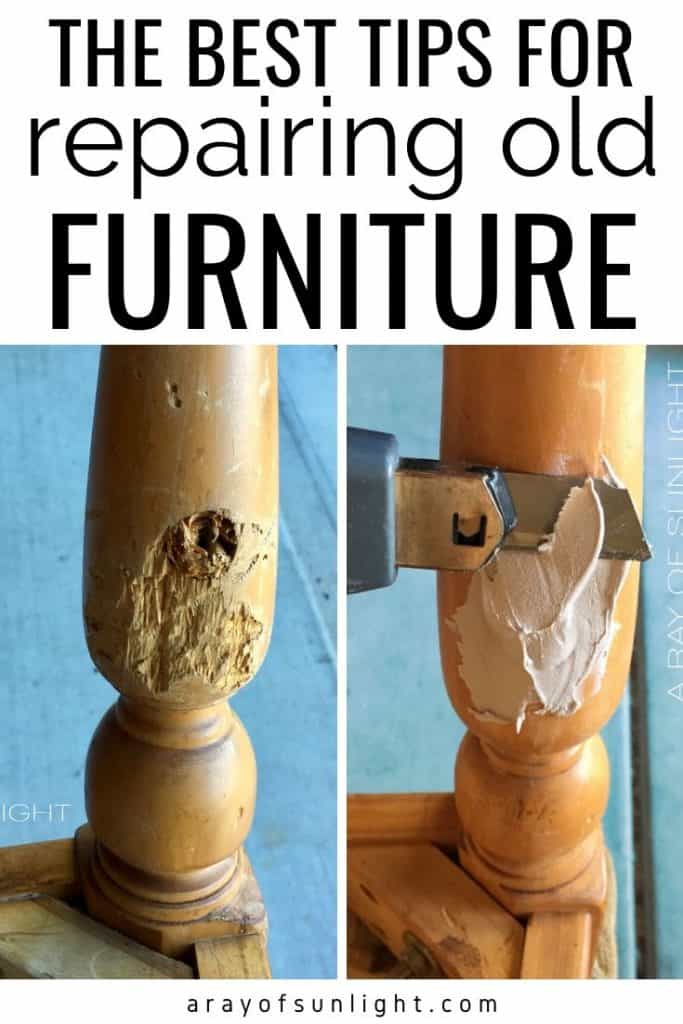You don’t have to get rid of your old furniture when it breaks or gets damaged! Use these tips for repairing old furniture to update and love your furniture again. You can also use these tips on thrifted furniture to decorate your home on a budget.
At A Ray of Sunlight we’ve been painting and selling furniture since 2014. So I’ve had plenty of furniture repairs to learn how to make… and I made plenty of mistakes, that became lessons in the end. Keep reading to learn more about the best ways to repair old furniture before painting!
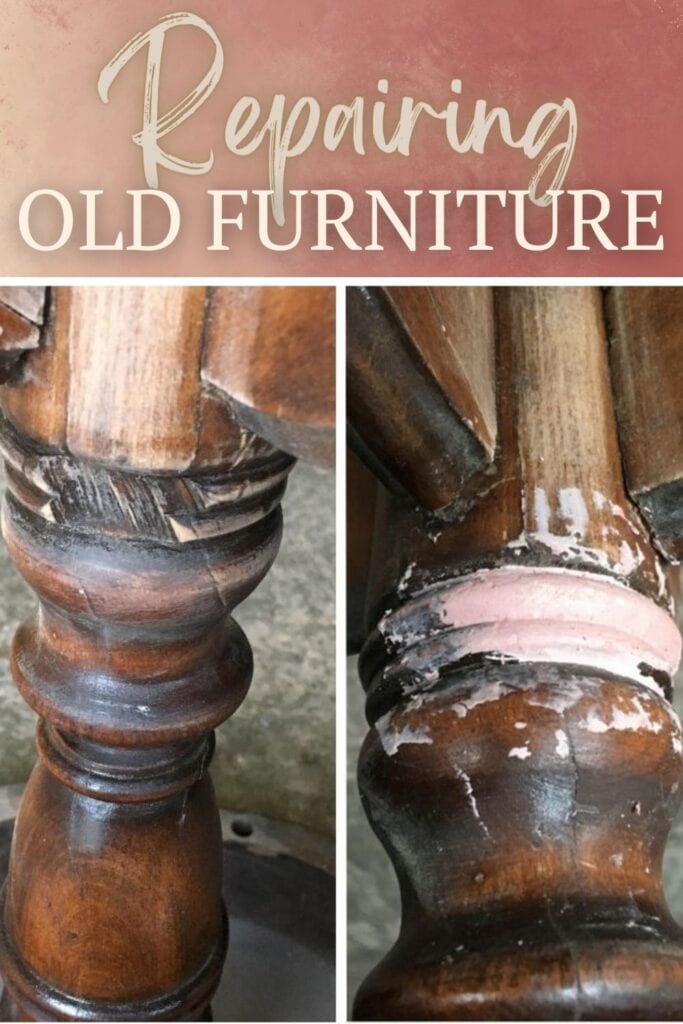
Old wood furniture is notorious for having damage. From chipping veneer or peeling veneer, to chewed up furniture, and missing or broken trim.
Even more common is sticky dresser drawers and broken furniture legs. Instead of getting rid of it, you can easily repair furniture damage with these tips for repairing old furniture.
Each of these furniture repair tutorials walk you through, step by step, how to repair damaged furniture so you can fall back in love with your furniture.
Or you can use these on thrifted dressers, buffets, nightstands or tables to decorate your home on a budget.
Best Tips For Repairing Old Furniture
When it comes to fixing old furniture, there’s no one-size-fits-all solution.
First, it’s important to assess the damage and determine what needs to be repaired. This will help you gather the necessary materials and tools before getting started.
Repairing old furniture can also be a slow process, but it’s important to take your time and do it right. Rushing through repairs may lead to mistakes or subpar results.
You should make sure to use proper safety precautions when handling and using tools. Wear protective gear, such as goggles and gloves, to avoid injuries.
Wood Furniture Repair

Furniture repair is a valuable skill to have when it comes to maintaining and updating your home decor. This process involves fixing damaged or broken furniture, whether it be due to age, wear and tear, or even accidents.
By learning how to repair furniture, you can save money by not having to replace expensive pieces and also give new life to old pieces with sentimental value.
- How to Repair Rattan Furniture
- How to Repair Damaged Furniture
- How To Fix Damaged Wood Furniture Before Painting
- How to Repair Broken Trim on Furniture
- How To Fix A Missing Chunk Of Wood
- How To Fix Dog Chewed Wood Trim
- Cane Furniture Repair
- How to Save & Repair Furniture by Rebuilding the Damage Area
- How To Repair Cracks In Antique Wood Furniture
- Repair Water Damaged Wood
- How To Repair Damaged Wood Finish
- Wood Surface Repair
- How To Repair Broken Wood
- How To Repair Damaged Particle Board Furniture
- Best Glue For Repairing Wood Furniture
- The Best Wood Repair Putty
- How To Repair Chipped Paint On Wood
How to Repair Veneer
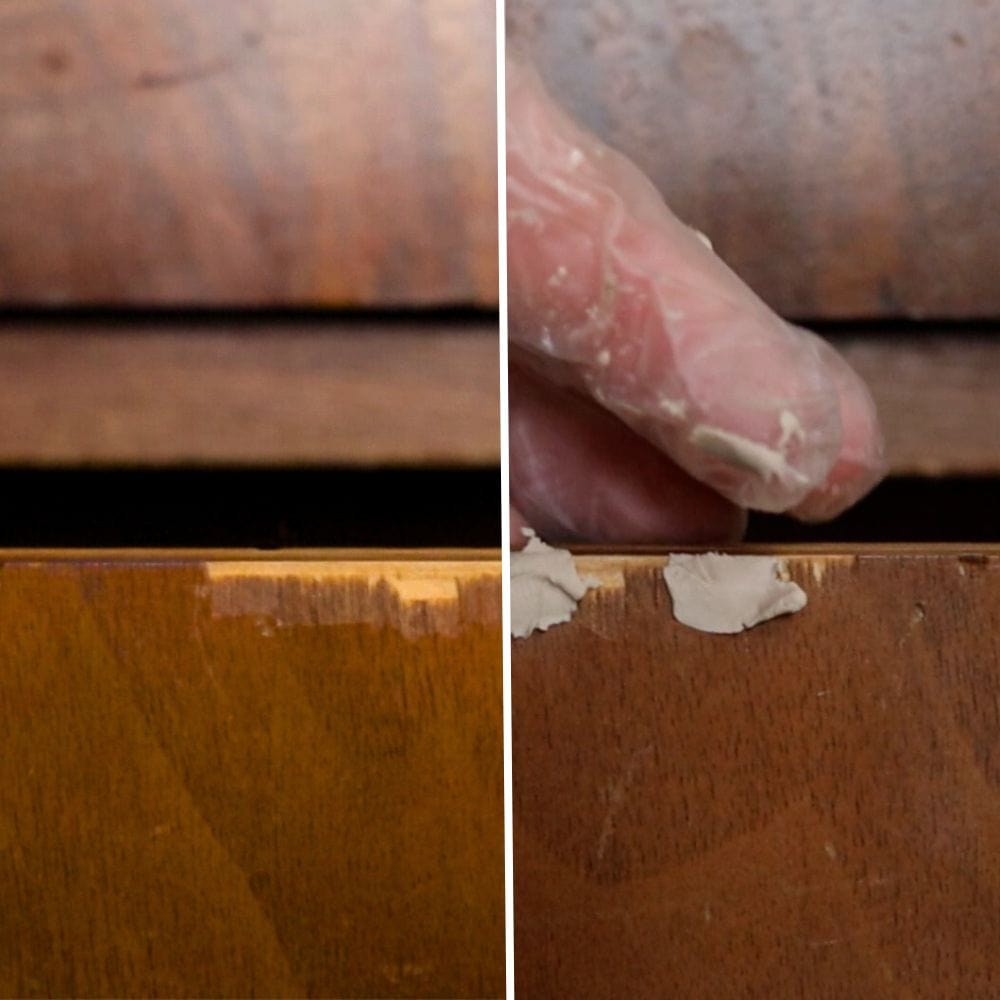
Furniture veneer is a thin layer of wood that is often used to cover the surfaces of furniture, giving it an attractive and polished look.
However, over time this veneer can become damaged and start to chip or peel off.
There are several methods you can use to fix damaged veneer and have your furniture looking as good as new.
- Repairing Veneer with Wood Filler
- The Insanely Easy Way to Remove Veneer
- How to Repair (and Stain) Chipped Veneer Furniture
- How to Fix a Chipped Wood Corner
- How to Repair Bubbled Veneer
- How to Fix Chipped Wood Furniture
- How to Fix Damaged Veneer for Paint – Black Painted Antique Buffet
- How To Fix Veneer That Is Lifting
- How To Repair Veneer Edging
Wood Furniture Legs

One of the most common issues with old furniture is having legs that are broken or missing. But before you toss out your beloved piece, try these tips for fixing and adding wood furniture legs.
Your furniture will regain its sturdy foundation in no time.
- How to Repair Legs – Chalk Painted Nightstand Makeover
- Adding Legs to a Dresser
- Adding Legs to a Cedar Chest
- Adding Legs to a Nightstand
- How To Add Legs To A Buffet
- How To Add Legs To A Cabinet
- The Best Wood Legs to Add to Furniture
How to Update Old Furniture
These tips and tricks will help you maintain the best quality and aesthetics of your furniture, or even give it a new look.
So don’t toss out that old piece of furniture just yet – with regular upkeep and occasional updates, it can continue to serve as a beautiful and functional piece in your home for years to come.
- How to Disinfect Wood Dresser
- How to Get Rid of Smoke Smell in Furniture
- How To Clean Old Furniture Hardware
- How to Change Hardware on a Dresser
- Wood Stain Repair
Dresser Drawer Repair and Maintenance
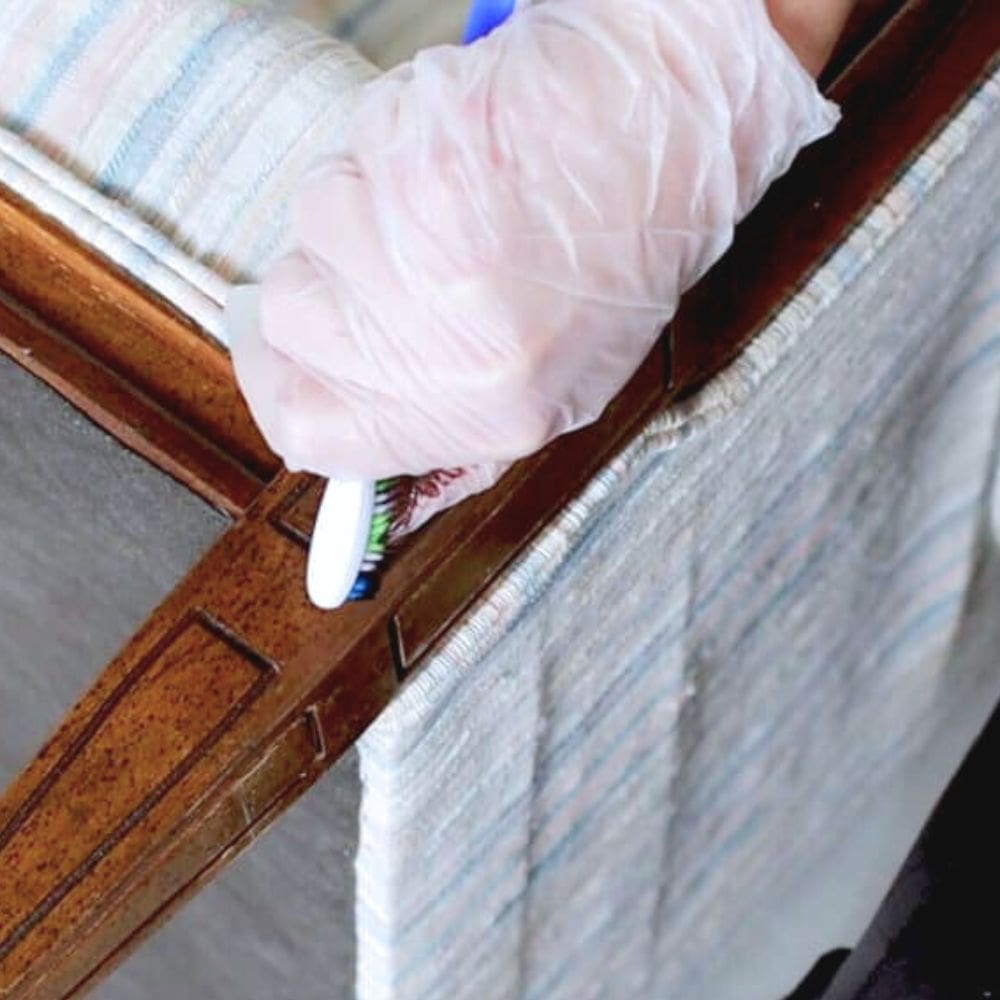
Instead of getting frustrated and immediately replacing your old furniture, use these step by step guides to fix old dresser drawers.
You’ll be surprised at how easy it is to repair your dresser drawers and make them work like new again.
And if you’ve thrifted a dresser with damaged drawers, these tips will also come in handy for restoring them and making them fully functional.
- How to Fix Old Dresser Drawers that Stick
- How To Fix Old Dresser Drawers From Falling Out
- Old Dresser Drawers Won’t Slide
- Dresser Drawer Bottom Replacement
- Old Dresser Drawers Hard to Open
- How to Fix a Dresser Drawer Side
- How to Repair Worn Drawer Runners
- How to Fix Sagging Dresser Drawers
- How to Disinfect Wood Dresser
- How to Fix Dresser Drawers Bottom
- How to Fix Broken Dresser Drawer Tracks
Wood Filler Repair
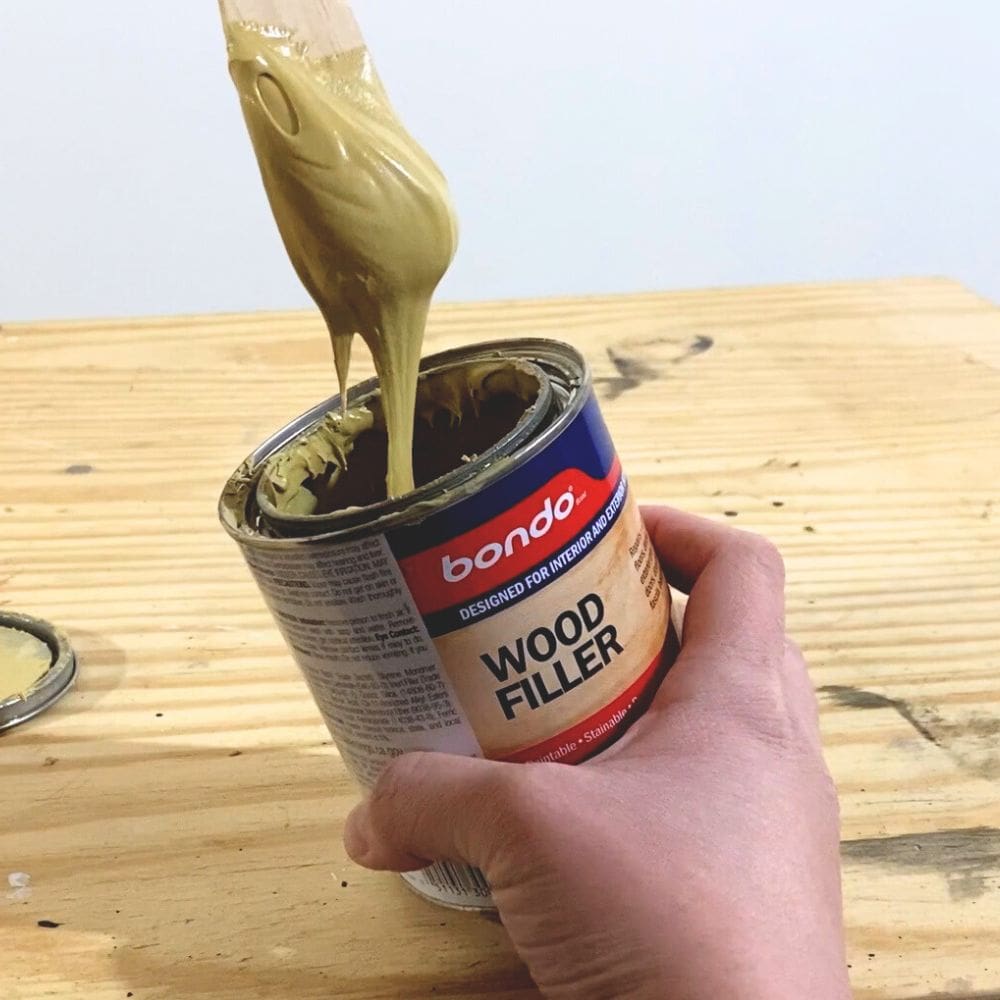
In addition to learning how to fix specific furniture repairs, it’s also helpful to know which products are best for the job.
These wood filler posts give an honest look at popular options on the market so you can choose the right one for your next project with confidence.
How do I know if my furniture needs to be repaired or replaced?
If your furniture is showing signs of significant damage, it may be time to consider either repairing or replacing it.
However, small issues such as scratches or minor wear and tear can often be fixed easily with the above DIY techniques.
Ideally, you should inspect your furniture regularly and address any repairs as soon as possible to prevent any damage from worsening.
How do I prevent future damage to my furniture?
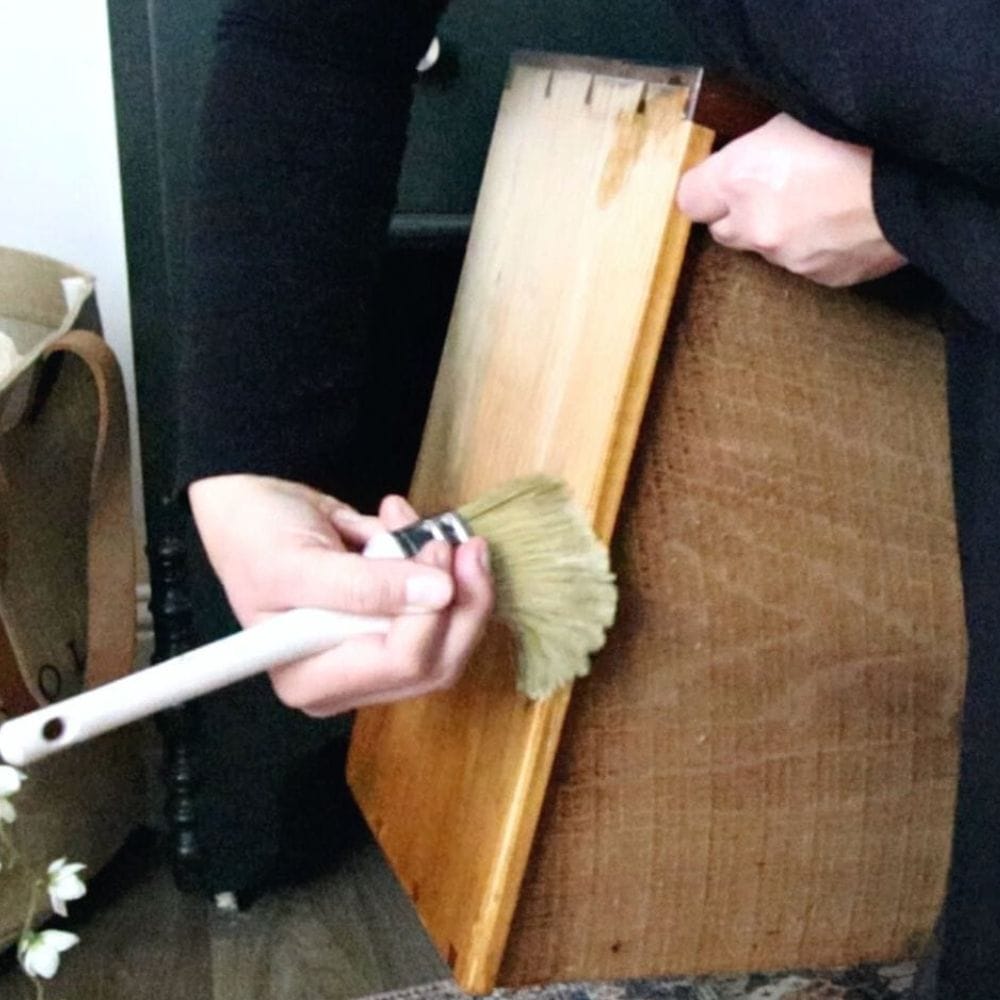
Regular maintenance and proper care can help prevent future damage to your furniture.
This includes avoiding extreme temperature and humidity changes, using protective coasters or pads, and regularly cleaning and dusting.
It’s also important to handle furniture with care and avoid placing heavy objects on delicate surfaces.
Don’t let damaged furniture discourage you from keeping it in your home. With the right tools and techniques, you can easily repair and maintain your furniture for long-lasting use and enjoyment.
Remember to always approach these repairs with a positive attitude and take the time to properly research and choose the best products for the job.
So the next time you come across a broken leg or chipped veneer, don’t panic – instead, use these resources to give your furniture the TLC it deserves.
What are some common mistakes to avoid when attempting DIY furniture Fix?
When attempting DIY furniture repairs, there are a few common mistakes that can lead to even bigger problems.
One of the biggest mistakes is not using the right tools or materials for the job. It’s important to research and choose the appropriate products and techniques for specific furniture repairs.
Using the wrong ones can make things worse or result in a less than satisfactory fix.
One more mistake is rushing through the repair process without properly assessing the issue and following all necessary steps.
This can result in a messed-up repair job that requires even more effort and resources to fix. Take your time, read instructions carefully, and don’t hesitate to ask for help or advice if you need it.
Lastly, not properly preparing the furniture before starting repairs can also lead to mistakes. It’s important to thoroughly clean and dry the area before applying any products or tools, as dirt and moisture can affect their effectiveness.
It’s also helpful to have a clear work space and all necessary materials ready before starting the repair process.
By being aware of these common mistakes and taking the necessary precautions, you can avoid making costly errors when attempting DIY furniture repairs.
Remember to always approach repairs with patience and care, and don’t hesitate to reach out to a professional if a repair seems too daunting or complex for you.
With the right approach and mindset, you can successfully fix your furniture and extend its lifespan for years to come.
More Painting Furniture Resources
- Painting Furniture
- Types of Paint for Furniture
- Furniture Painting Tools And Supplies
- Refinishing Furniture
- How To Quickly Remove Wood Veneer With A Heat Gun
Follow us on YouTube to get more tips for painting furniture.
Or share your project with us on our Facebook Group and be part of our community. See you there!

